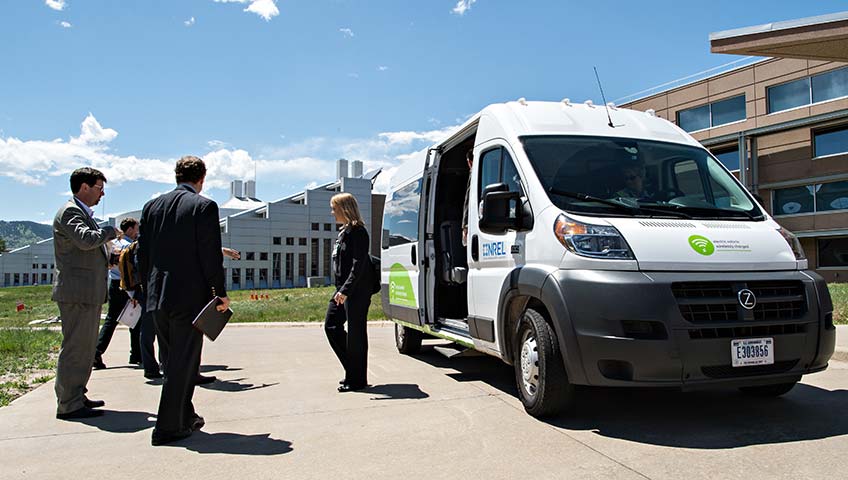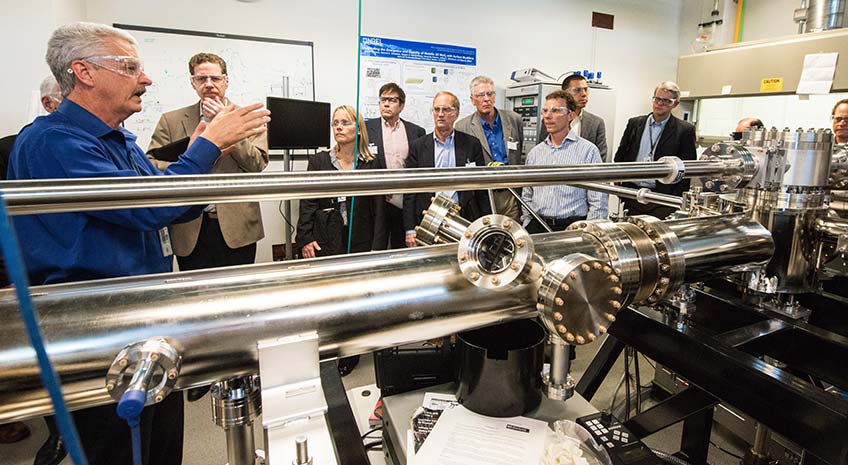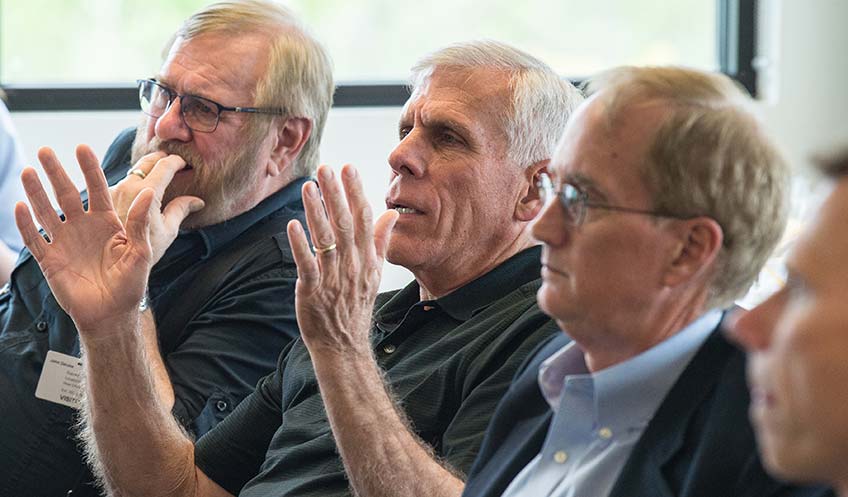NREL, DOE, and U.S. Automakers Join Together to Transform Mobility Future

Attendees from USCAR toured the NREL campus via an electric Zenith Motors van that charges wirelessly. Photo by Dennis Schroeder, NREL
The first automobile was invented in 1885, and then 71 years later, in 1956, the interstate system was created. A more recent revolutionary step in our population's mobility is currently underway with the advent of hybrid and electric vehicles (EVs) along with connected and autonomous transportation options, spurred on by decades of research expertise from the National Renewable Energy Laboratory (NREL) and its partners. With transportation costs second only to housing expenses for the average American, the lab is now poised to roll out even more dramatic innovations that can help consumers save money, while also delivering safe, high-performance, energy-efficient mobility options.
Today, mobility is more than vehicles and the roads they travel. NREL scientists are developing and integrating vehicle and infrastructure technologies with big data and communication systems to connect and automate transportation. NREL shares those insights with carmakers developing tomorrow's vehicles through partnerships with organizations such as the United States Council for Automotive Research (USCAR), which represents Fiat Chrysler, Ford, and General Motors.
In May, NREL hosted USCAR directors and representatives from the U.S. Department of Energy's (DOE) Vehicle Technologies Office for a discussion on research required to drive vehicle technology into the future. NREL has worked with USCAR since the council's inception in 1992. Under the Partnership for a New Generation of Vehicles initiative, NREL's relationship with USCAR resulted in the development of the world's first production-feasible hybrid vehicle prototypes.
NREL Director Martin Keller shared the laboratory's research initiatives related to transportation and emerging research of interest to automakers. NREL's top transportation researchers presented on a suite of prescient topics and treated visitors to tours of state-of-the-art facilities and labs throughout the main campus.
“NREL scientists have a history of collaborating with America's automakers to advance mobility options,” said Chris Gearhart, director of NREL's Transportation & Hydrogen Systems Center. “Our researchers work with a variety of organizations and industries to create next-generation mobility solutions that have real-world applications and can help automakers' make the vehicles of tomorrow a reality today.”

Vehicle Electrification Group Manager Matt Keyser explains the technology behind his battery research to visitors from USCAR and DOE’s Vehicle Technologies Office, and NREL colleagues. Photo by Dennis Schroeder, NREL
With the advent of connected and autonomous vehicle technologies and integration with renewable power sources, the grid, buildings, and other systems, NREL is not only looking for ways to help reduce transportation costs, but also plan ahead as the U.S. population shifts to urban mega-regions. Efficient passenger and freight mobility solutions are necessary as more than three trillion vehicle miles are traveled by people living in large cities, one-third of which are to get to and from work.
The on-demand economy has disrupted the traditional modes of mobility for both people and goods across the country. Case in point is the striking increase in ride-hailing services that consumers access via smartphone apps to schedule and pay for a car service to work, social occasions, family visits, and even food delivery.
Looking even further into the future, advances in connected and autonomous vehicle technologies may lead to automated mobility districts that would include self-driving vehicles used primarily within a confined area, such as college and business campuses, but also to allow movement between districts. The technology is within reach as many vehicles on the road today can already detect activity from other automobiles and use automation to engage safety features.
Expanded communication among vehicles, buildings, road infrastructure, and the grid will make it possible to track and adjust traffic patterns to prevent congestion in real time and balance energy demands. These advances will enable mobility choices that are efficient, reliable, and affordable, with the strong potential to ultimately improve quality of life and productivity for consumers and industry.

Materials and Chemical Science and Technology Chief Technologist Tony Burrell gives an overview of NREL’s Science and Technology Facility capabilities to representatives from DOE’s Vehicle Technologies Office and USCAR. Photo by Dennis Schroeder, NREL
Vehicle Electrification Today and Tomorrow's Integration Within Reach
EVs are already here—the next step is to alleviate the higher sticker prices and range anxiety often cited by consumers as barriers to adoption. Solutions in development include extreme fast charging, more charging infrastructure, and new materials and designs that can make batteries smaller and less expensive, but more efficient and longer lasting. Removing barriers and encouraging workplace and public installation of charging infrastructure, in combination with grid integration to transfer power based on need, are areas of research by NREL scientists to help bring widespread electrification closer to reality.
Batteries are at the epicenter of ensuring EV use continues to grow. Several large countries, including China, mandate battery recycling. While the U.S. is not currently among them, knowing that 12-volt lead-acid batteries from cars are one of the most recycled products in the country gives hope that lithium-ion (Li-ion) batteries can also be recycled or repurposed. Because the demand for Li-ion batteries for automotive applications surpasses their use in consumer electronics, understanding how to use earth-abundant elements to create the next generation of advanced battery chemistries can propel the industry forward.
Delivering Higher Performance and Cleaner Air
Under NREL's lead for the DOE's Office of Energy Efficiency & Renewable Energy, nine national laboratories, 13 universities, and numerous industry and government stakeholders are working together to explore solutions with potential for near-term improvements to the types of fuels and engines found in most vehicles currently on the road, as well as the development of revolutionary new combustion technologies. This insight is providing industry with the scientific underpinnings needed to accelerate introduction of high-performance fuels and engines that reduce energy consumption, improve air quality, and lower drivers' costs. This could increase the country's domestic fuel supplies by 25 billion gallons per year while leveraging the nation's existing $1 trillion fuel infrastructure.

USCAR Executive Director Steve Zimmer makes a point at the organization's director's meeting at NREL's Golden campus. Photo by Dennis Schroeder, NREL
Making the Mobility Revolution a Reality Today
At the meeting's conclusion, USCAR directors and NREL researchers had a lively discussion about the technologies that would be most important for the national laboratories to engage in. Areas of focus included targeted cybersecurity, high-performance computing to create algorithms that will further automate vehicles, and advancements in fuels and breakthroughs in battery chemistries. The ability to leverage domestic energy resources and provide consumers and businesses with more mobility options, along with integrated systems in which vehicles talk with roads, buildings, and the grid is within reach.
Learn more about NREL's work with industry and its latest transportation research.
Last Updated May 28, 2025
